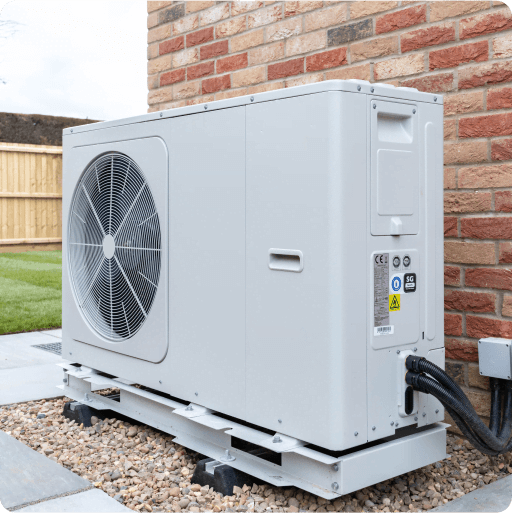
How Does an Air Source Heat Pump Work?
How Does an Air Source Heat Pump Work?
An air source heat pump might just be the perfect solution for homeowners seeking an eco-friendly, energy-efficient way to heat their homes and reduce their carbon footprint. But how does it actually work? Can it really cut your energy bills and keep your home comfortable all year round without relying on fossil fuels?
This blog will walk you through the technology behind air source heat pumps, explain how they operate, and show why they are becoming a popular choice among eco-conscious homeowners.
What Is an Air Source Heat Pump?
An air source heat pump (ASHP) is a renewable heating system that transfers heat from outside air into your home. Yes, even on cold days. The system uses advanced technology to extract energy from the air, amplify it, and deliver that heat to your central heating and hot water systems.
Unlike traditional boilers or furnaces, an air source heat pump doesn’t burn fuel to generate heat. Instead, it uses electricity to transfer heat from one place to another, making it an environmentally friendly option for heating your home.
How Does an Air Source Heat Pump Work?
Air source heat pumps rely on a simple yet highly efficient process.
1. Heat Absorption
The heat pump starts by drawing in air from the outside and passing it over a refrigerant-filled evaporator coil. Even if the air is cold (yes, air still contains heat even in winter!), the refrigerant absorbs this heat, converting it from a liquid to a gas state.
2. Compression
Next, the gaseous refrigerant is compressed, which increases both its pressure and temperature. This step is where the magic happens—compressing the gas amplifies the heat it carries.
3. Heat Exchange
The heat from the compressed refrigerant is then transferred to the water in your central heating system. This heated water is pumped into radiators, underfloor heating systems, or hot water tanks to keep your home warm and cozy.
4. Cooling and Reuse
After releasing its heat, the refrigerant cools back down and reverts to its liquid state. The cycle then begins again, continuing to pull heat from the air and transfer it into your home.
This process ensures that the system operates efficiently year-round, even in temperatures as low as -4°F with some models.
Why Choose an Air Source Heat Pump?
Air source heat pumps come with a host of benefits that make them an attractive choice for energy-conscious homeowners:
1. Energy Efficiency
For every unit of electricity used, an air source heat pump can produce 3 to 4 units of heat, making it up to 400% efficient. This is a significant improvement compared to fossil fuel-based heating systems.
2. Lower Carbon Footprint
By relying on heat sourced from the air, ASHPs dramatically reduce the amount of greenhouse gases emitted. They’re ideal for homeowners looking to transition away from fossil fuels and adopt a greener lifestyle.
3. Cost Savings
Switching to an air source heat pump can help lower your energy bills once installed. While upfront costs may seem high, government-backed grants and incentive programs (like the Inflation Reduction Act in the U.S. or the Renewable Heat Incentive in the UK) are available to help you make the switch.
4. Heating and Cooling in One
The versatility of an ASHP doesn’t stop at heating. Many systems can reverse the process during hot months to cool your home, acting as an all-in-one climate control solution.
5. Durability and Low Maintenance
With a lifespan of 15–20 years and fewer moving parts than traditional heating systems, air source heat pumps require minimal maintenance. Regular servicing ensures peak performance without much hassle.
Is an Air Source Heat Pump Right for You?
Before making a decision, it’s important to consider the following:
- Your Climate: Air source heat pumps perform best in moderate climates, but modern advancements allow them to function effectively in colder regions as well.
- Space Requirements: The system needs outdoor space for the pump, as well as room for the indoor components.
- Insulation: Proper insulation is key to maximizing efficiency; a well-insulated home ensures the heat stays indoors longer.
- Upfront Cost: While installation costs can be significant, available grants and reduced energy bills often offset these expenses over time.
Take the Next Step Toward Greener Heating
Adopting an air source heat pump isn’t just an investment in your home—it’s an investment in the planet. With their impressive efficiency, environmental benefits, and ability to reduce energy bills, they represent a future-proof solution for heating your home.
If you’re considering upgrading to an air source heat pump, our team’s extensive expertise can guide you through the process, from initial consultation to installation. We ensure the entire process is smooth, affordable, and tailored to your needs.
Contact us today to learn more about how an air source heat pump could transform your home’s heating system and reduce your environmental impact. This could be the upgrade your home—and the planet—needs.

